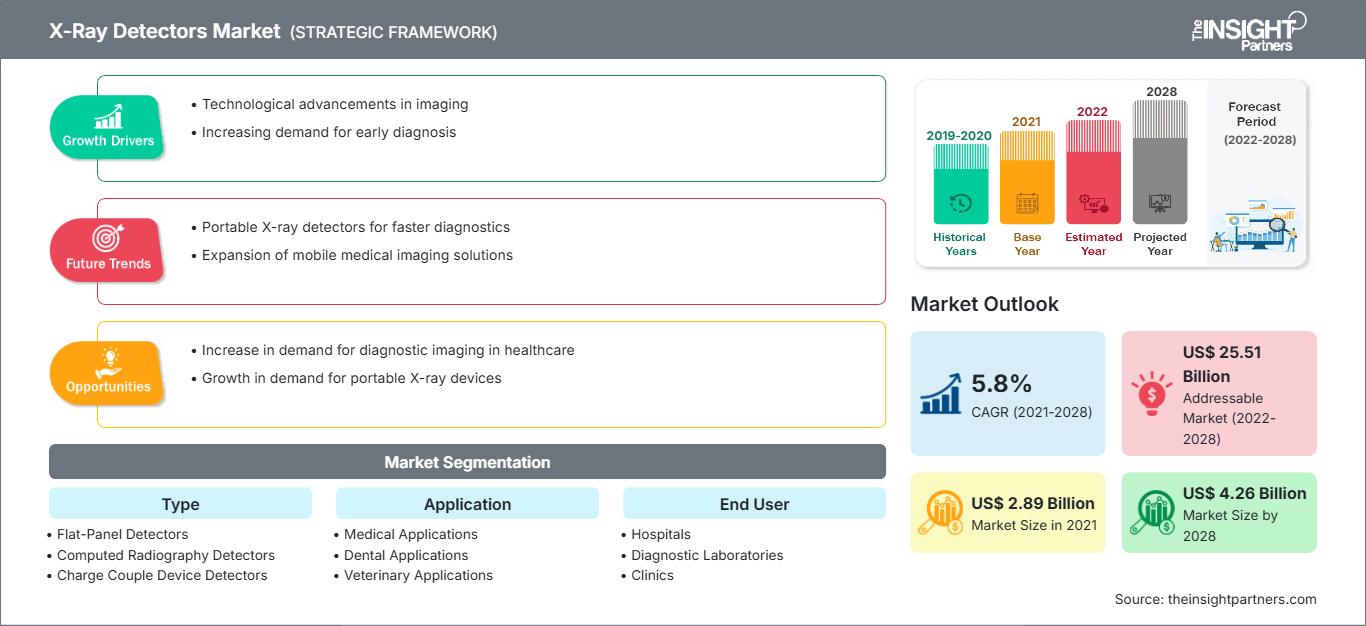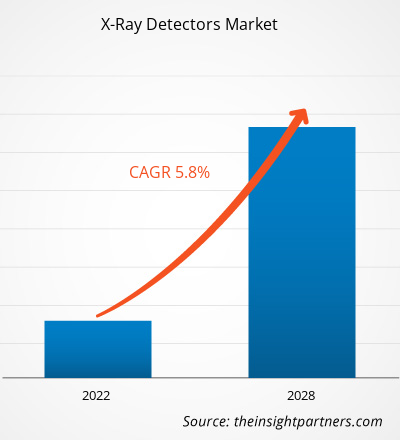[Rapport de recherche] Le marché des détecteurs de rayons X devrait atteindre environ 4 256,75 millions de dollars américains d'ici 2028 ; sa croissance devrait atteindre un TCAC de 5,8 % entre 2022 et 2028.
Les détecteurs de rayons X sont des appareils utilisés pour mesurer le flux, la distribution spatiale, le spectre et/ou d'autres propriétés des rayons X. Dans le secteur de la santé, les détecteurs de rayons X sont couramment utilisés dans les applications médicales à diverses fins de diagnostic. La conception des détecteurs de rayons X diffère, entre autres, en termes de taille, de forme, de résolution spatiale, de fréquences d'images et de flux de rayons X, afin de répondre aux exigences des applications.
Le marché des détecteurs de rayons X est segmenté en fonction du type, de l'application, de l'utilisateur final et de la géographie. Par géographie, le marché est largement segmenté en Amérique du Nord, Europe, Asie-Pacifique, Moyen-Orient et Afrique, et Amérique du Sud et centrale. Ce rapport offre des informations et une analyse approfondie du marché, en mettant l'accent sur des paramètres tels que les tendances et la dynamique du marché ainsi que sur l'analyse concurrentielle des principaux acteurs du marché mondial.
Personnalisez ce rapport en fonction de vos besoins
Vous bénéficierez d’une personnalisation sur n’importe quel rapport - gratuitement - y compris des parties de ce rapport, ou une analyse au niveau du pays, un pack de données Excel, ainsi que de profiter d’offres exceptionnelles et de réductions pour les start-ups et les universités
Marché des détecteurs de rayons X: Perspectives stratégiques

-
Obtenez les principales tendances clés du marché de ce rapport.Cet échantillon GRATUIT comprendra une analyse de données, allant des tendances du marché aux estimations et prévisions.
Aperçu du marché
Les principaux facteurs à l'origine de la croissance du marché comprennent l'augmentation de l'incidence et de la prévalence des maladies chroniques, ainsi que les lancements et les homologations de produits.
Les maladies chroniques telles que les maladies cardiovasculaires, respiratoires et orthopédiques, ainsi que divers types de cancer, entraînent des invalidités et des décès dans le monde entier. Ces affections cliniques affectent la qualité de vie globale. Selon l'Organisation mondiale de la santé (OMS), plus de 50 % de la population mondiale souffrirait d'au moins une maladie chronique. Les Centres pour le contrôle et la prévention des maladies (CDC) ont déclaré que 6 personnes sur 10 aux États-Unis souffraient d'au moins une maladie chronique en 2019. Les maladies cardiovasculaires (MCV), dues à un mode de vie trépidant, sont une cause importante de mortalité dans le monde. Les troubles orthopédiques comptent parmi les principales causes d'années de vie corrigées de l'incapacité (AVCI) observées dans la vaste population gériatrique à l'échelle mondiale. Selon un article publié par SingleCare, plus de 350 millions de personnes dans le monde souffraient d'arthrite en 2021. Des pays comme les États-Unis, le Japon, la Corée du Sud, le Canada, le Royaume-Uni, l'Espagne et la France connaissent une croissance substantielle de la population gériatrique. Ces économies, ainsi que la Chine, l'Inde, l'Arabie saoudite, les Émirats arabes unis et le Brésil, offrent d'importantes opportunités de croissance pour l'introduction de dispositifs innovants sur le marché mondial des détecteurs de rayons X.
Voici quelques exemples de développements qui ont favorisé la croissance du marché des détecteurs de rayons X :
- En octobre 2022, Rigaku Corporation, l'un des principaux fabricants d'équipements d'analyse et d'inspection par rayons X, a lancé son nouveau détecteur XSPA-400 ER (X-ray Seamless Pixel Array) sur le marché mondial, après un lancement national réussi au JASIS (Japan Analytical and Scientific Instruments Show) en septembre 2022. Le XSPA-400 ER est un détecteur multidimensionnel à pixels continus pour diffractomètres de rayons X avec une résolution en énergie élevée adaptée à l'analyse des batteries, de l'acier et de la céramique.
- En août 2021, Rigaku Corporation a acquis toutes les actions émises de MILabs BV le 2 août 2021, dans le cadre de ses efforts à grande échelle pour entrer dans le secteur des sciences de la vie. Grâce à cette acquisition, Rigaku étendra ses activités dans le secteur des sciences de la vie à l'échelle mondiale en combinant MILabs ; Activités multimodales, notamment la tomographie par émission de positons (TEP), la tomographie par émission monophotonique (SPECT), l'imagerie optique et les équipements de tomodensitométrie (TDM) pour animaux, avec l'activité d'imagerie par rayons X originale de Rigaku pour animaux.
- En septembre 2021, Canon a acquis Redlen. Cette acquisition permettra à Canon d'obtenir une technologie avancée de détection et d'imagerie des rayonnements utilisée dans les modules de détection à semi-conducteurs CZT, qui jouent un rôle important dans le développement de la TDM à comptage de photons (PCCT). Cela permettra à Canon Medical Systems Corporation, également filiale de Canon, d'accélérer le développement de systèmes PCCT compétitifs pour renforcer l'activité des systèmes médicaux.
Informations sur les produits
Le marché des détecteurs de rayons X est segmenté en fonction du type : détecteurs de radiographie informatisée (CR), détecteurs à écran plat, détecteurs à balayage linéaire et détecteurs à dispositif à couplage de charge (CCD). Le segment des détecteurs à écran plat a détenu la plus grande part de marché en 2021 et devrait enregistrer le TCAC le plus élevé au cours de la période de prévision. Les systèmes à rayons X utilisent souvent des détecteurs à écran plat indirects pour convertir l'énergie des rayons X en énergie lumineuse, laquelle est ensuite utilisée pour générer des images d'inspection. Les détecteurs à écran plat sont également utilisés en radiographie numérique pour convertir les rayons X en charge (conversion directe), qui est ensuite interprétée à l'aide d'un réseau de transistors à couches minces.
Aperçu régional du marché des détecteurs de rayons X
Les tendances régionales et les facteurs influençant le marché des détecteurs de rayons X tout au long de la période de prévision ont été analysés en détail par les analystes de The Insight Partners. Cette section aborde également les segments de marché et la géographie des détecteurs de rayons X en Amérique du Nord, en Europe, en Asie-Pacifique, au Moyen-Orient et en Afrique, ainsi qu'en Amérique du Sud et en Amérique centrale.
Portée du rapport sur le marché des détecteurs de rayons X
| Attribut de rapport | Détails |
|---|---|
| Taille du marché en 2021 | US$ 2.89 Billion |
| Taille du marché par 2028 | US$ 4.26 Billion |
| TCAC mondial (2021 - 2028) | 5.8% |
| Données historiques | 2019-2020 |
| Période de prévision | 2022-2028 |
| Segments couverts |
By Type
|
| Régions et pays couverts |
Amérique du Nord
|
| Leaders du marché et profils d'entreprises clés |
|
Densité des acteurs du marché des détecteurs de rayons X : comprendre son impact sur la dynamique des entreprises
Le marché des détecteurs de rayons X connaît une croissance rapide, portée par une demande croissante des utilisateurs finaux, due à des facteurs tels que l'évolution des préférences des consommateurs, les avancées technologiques et une meilleure connaissance des avantages du produit. Face à cette demande croissante, les entreprises élargissent leur offre, innovent pour répondre aux besoins des consommateurs et capitalisent sur les nouvelles tendances, ce qui alimente la croissance du marché.

- Obtenez le Marché des détecteurs de rayons X Aperçu des principaux acteurs clés
- Analyse historique (2 ans), année de base, prévision (7 ans) avec TCAC
- Analyse PEST et SWOT
- Taille du marché Valeur / Volume - Mondial, Régional, Pays
- Industrie et paysage concurrentiel
- Ensemble de données Excel
Rapports récents
Rapports connexes
Témoignages
Raison d'acheter
- Prise de décision éclairée
- Compréhension de la dynamique du marché
- Analyse concurrentielle
- Connaissances clients
- Prévisions de marché
- Atténuation des risques
- Planification stratégique
- Justification des investissements
- Identification des marchés émergents
- Amélioration des stratégies marketing
- Amélioration de l'efficacité opérationnelle
- Alignement sur les tendances réglementaires






















 Obtenez un échantillon gratuit pour - Marché des détecteurs de rayons X
Obtenez un échantillon gratuit pour - Marché des détecteurs de rayons X